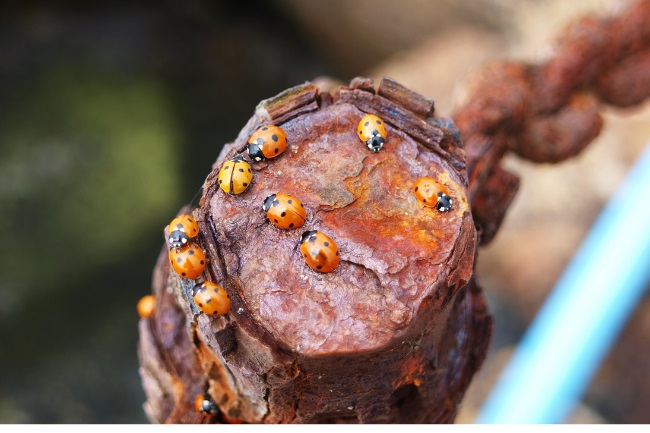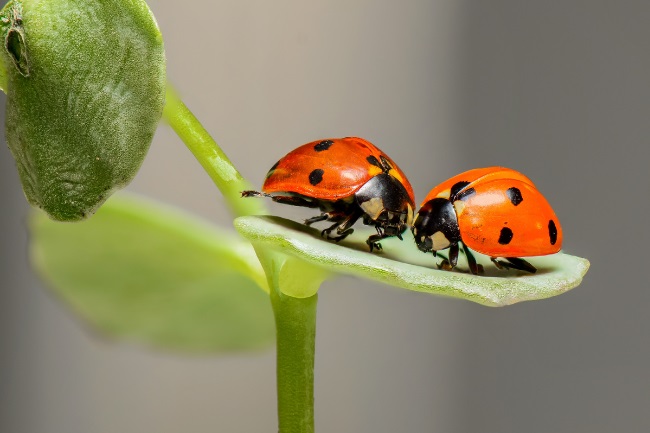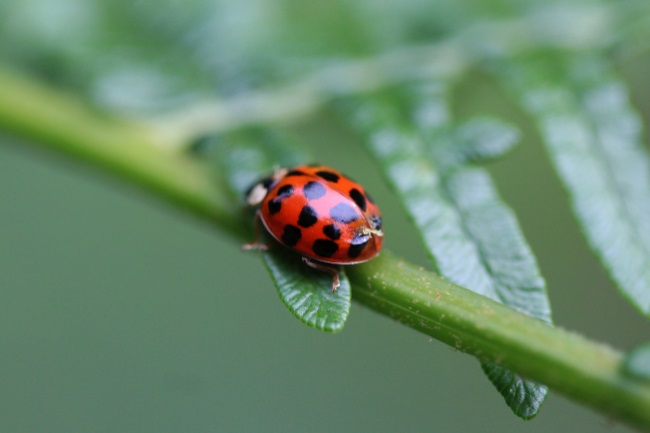Ladybugs are often called the gardener’s friend, as the vast majority of species help us out by eating aphids and other sapsucking insects that may damage plants. The best way to attract them into the garden is to give them plenty to eat and a comfortable place to sleep.
Contents
Provide plenty of snacks

It stands to reason that all animals need food and water in some form or other. Though some will stay put no matter what, the majority will spend their time moving from place to place to find enough to eat. From the great wildebeest migrations, following the rains to feast on the young grass shoots that flourish, to butterflies moving from field to field looking for pollen, animals are almost always on the hunt for food.
| Food Source | Description |
|---|---|
| Aphids | Aphids are a favorite food of ladybugs, and having a population of aphids in your garden can help attract ladybugs. |
| Mealybugs | Ladybugs also feed on mealybugs, which are small, soft-bodied insects often found on the stems and leaves of plants. |
| Scale Insects | Scale insects, which are commonly found on trees and shrubs, can be a food source for ladybugs as well. |
| Mites | Some species of ladybugs feed on plant-feeding mites, such as spider mites, which can be a pest in gardens. |
Adult ladybirds can fly, meaning they are able to move from place to place, easily locating suitable feeding grounds. They particularly select areas with plentiful food supplies when laying their eggs, so that their young can feast once they’ve hatched.
Therefore, the best way to call ladybugs into your garden is by having plentiful pests for them to dine on. As well as a meaty meal, many ladybugs also eat a small amount of pollen, meaning that you can also plant certain flowers to attract them into your garden. These can include marigolds and sunflowers, as well as herbs such as parsley and coriander.
Avoid nasty chemicals
It stands to reason that ladybugs aren’t going to be very happy if you’re dosing your garden with insecticides. You might be aiming to kill off harmful pests, but many pesticides can’t differentiate between insects we considered beneficial and those we deem to be harmful. Some can even travel up the food chain, with birds and mammals eating the dying insects and becoming sick over time.
Even if you manage to avoid harming the ladybugs themselves, you may well just have killed off their food. While you might not like the fact that aphids are feasting on your roses, the ladybugs won’t bother visiting your garden if there isn’t some food to attract them in.
As much as possible, let nature take its course, and if it’s a healthy ecosystem, the predators and prey should balance each other out. You can try practising other pest control methods, such as companion planting, where you plant certain species next to those you want to encourage to bring in beneficial insects.
| Plant Name | Description |
|---|---|
| Yarrow (Achillea) | Yarrow produces small, flat clusters of flowers that attract ladybugs with their nectar and pollen. |
| Dill (Anethum) | Dill plants produce tiny yellow flowers that are highly attractive to ladybugs and provide a good source of food. |
| Calendula (Calendula officinalis) | Calendula flowers, with their bright colors and open shape, are known to attract ladybugs and other beneficial insects. |
| Fennel (Foeniculum vulgare) | Fennel plants produce umbrella-like clusters of tiny yellow flowers that are irresistible to ladybugs. |
| Cosmos (Cosmos bipinnatus) | Cosmos flowers are rich in nectar and provide a landing platform for ladybugs to feed on pollen and aphids. |
Provide a place to sleep
We rarely think of insects as getting some shut-eye, but they need a place to rest up just like the rest of us. Beyond sleeping, insects also require external warmth to keep themselves moves, meaning that when the sun goes down, or the winter descends, they naturally cease their activities.
While ladybugs do have their bright colours to put off potential predators, this doesn’t mean they wouldn’t rather hide away when at their most vulnerable. This means they like to take themselves into dark nooks and crannies, away from prying eyes or lumbering feet.
It’s important for these places not to be too dry or too wet. Too dry, and the ladybug may dry up itself. Too wet, and they may drown or become susceptible to moulds. Ideally, they prefer it if the space isn’t too big, so as not to allow predators to enter, but they often like to be tucked away with other ladybugs for warmth and protection.

In the winter, this is particularly obvious, with many ladybugs huddled together. During the winter, they enter diapause, which is similar to hibernation. Ladybugs will release a hormone, attracting others to them once they’ve found a suitable spot.
In the evenings, they usually trundle off to a quiet spot close to where they’ve been feeding, generally as the temperatures begin to drop. If there’s a sudden change in temperature during the day, they may be caught out and simply hunker down where they are, waiting out the chill till the sun returns.
So with all this in mind, what kind of cosy bed can we give our ladybug visitors? In a natural environment, wood and rock crevices would usually be what these creatures would go for. They will happily use artificial objects, such as plastic furniture; however, natural objects can provide multiple benefits for wildlife.
Creating a rockery or stumpery can be an excellent way to combine attractive garden features with wildlife-friendly homes. Bug hotels give the same shelter and can be a lovely way to engage children in wildlife. Still, commercially made ones are not always well designed and can be treated with harmful chemicals, so look for those recommended by environmental charities.
Other great ladybug shelters can be the plants in your garden themselves. By not cutting back vegetation in the winter, insects can use hollow stems or seed heads as homes. Even if you don’t want to leave everything standing, leaving a proportion to encourage insects to stick around till spring is highly beneficial.
Benefits of having ladybugs in your garden
Ladybugs are often referred to as the gardener’s friend. This is because the majority of ladybugs eat species we consider pests, particularly sap-sucking aphids, scale insects and mealybugs. These unwanted dinner guests are like plant mosquitos, pushing their stylets into the plant tissue and sucking out the lifeblood of the plant, their sap.
While individuals are too small to make an impact, the problems arise from the tendency for these species to appear in large numbers, infesting a plant until it succumbs under their constant feeding.
Sapsucking insects take so much sap out of the plant that they emit a sweet sticky substance known as honeydew. This is excreted by aphids and other sapsuckers to get rid of excess sugars and liquid.
Whole ecosystems are built upon the back of this process, with ants, caterpillars, and many other animals eating this waste product. Many ants even farm these tiny insects, milking them like cows for their tasty treat.
Once these insects have set up shop, it can be very hard to get rid of them, as they can reproduce at an astounding rate. This is where our ladybugs come in.
Ladybugs can eat approximately 50 aphids, or equivalent pest species, a day. They do this almost continuously from the moment they hatch to the moment they die. Adult ladybugs even lay their eggs on plants where sapsuckers have taken up residence, ensuring the hatching young have an easy meal.
Not all ladybugs are a gardeners friend

In the UK, there’s little to worry about when it comes to ladybugs. Of our 47 species, only around 10% eat plants or fungi. Of these, none are damaging to agriculture or gardeners, as they eat largely mildews or pollens.
However, not all countries are so lucky, and around the world, there are several damaging ladybug species, such as the potato beetle, which feasts on the leaves of potato plants. Another notable species is the squash beetle, which enjoys the leaves of plants within the pumpkin family.
Yet, despite these few bad eggs, most ladybugs globally are beneficial to humans and the systems we have created. Certainly, it would not be recommended to discourage all ladybugs for fear of these few deviants.
If you find that you have a visit from unfriendly ladybugs, the best thing to do is to remove the unwelcome guest manually, or if possible, remove those plants that are inviting them in.
A bright future
In the past, we humans have been too quick to dismiss all insects as unpleasant and detrimental. However, as we’re coming to understand our environment better and the role that different creatures play within it, we realise that most are highly beneficial and need to be protected or encouraged. Even those that are problematic have their upsides. We may not like aphids very much, but we love watching ladybugs trundle around our gardens.
Often living with nature is it of giving and take. We have to accept we can’t have it all our way. So maybe we learn to live with a few aphids to enjoy the bright and cheerful colours of the ladybugs.

